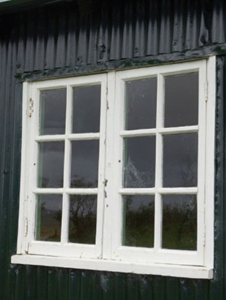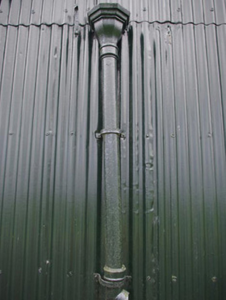Survey Data
Reg No
40910406
Rating
Regional
Categories of Special Interest
Architectural, Historical, Social
Original Use
Customs station
Date
1922 - 1940
Coordinates
199802, 367432
Date Recorded
05/10/2007
Date Updated
--/--/--
Description
Detached single-bay single-storey customs and excise patrol station, built c.1930. Now out of use. Pitched corrugated-metal roof with over-hanging eaves to side elevations (east and west) supported on projecting timber trusses. Aluminium rainwater goods and cast-iron downpipe with hopper to rear elevation (north). Corrugated-metal clad walls. Square-headed window opening to the west elevation having multiple-pane timber casement window and timber sill. Square-headed door opening to the south elevation having battened timber door. Timber plaque over doorway inscribed "TULLY CUSTOMS & EXCISE PATROL STATION" and "TULLACH CUSTAIN AGUS MÁL STÁSHON PATROL". Located adjacent to road to the south-east of Ballintra and to the west of Pettigoe, adjacent to the north of the border with County Fermanagh and Northern Ireland. Site bounded by rubble sandstone boundary wall with rubble stone coping over. Pedestrian gateway to the south, adjacent to road, comprising a pair of cast-iron gateposts with wrought-iron flat-bar gate.
Appraisal
This well-maintained if simple and utilitarian customs and excise patrol station retains its early form and character, as well as its salient fabric. It represents an interesting historical and social relic of the recent past when it would have been used by customs officers to monitor and collect duties on goods being brought into and out of the Irish Republic across the border with Northern Ireland to the east and to the south. It also provided a base to monitor smuggling between the two jurisdictions, which was a common occurrence, particularly during the so-called "Economic War" (1933-9) and the period of the "The Emergency" (1939-46). It may have been moved to its present location from another site close by. It was one of fifteen to seventeen (varied over time) officially designated border crossings with associated customs and excise patrol stations that were established following the financial/economic partition of the Republic and Northern Ireland in 1923, and it acts a simple reminder of this era of Ireland's history. It probably closed in 1993, if not considerably earlier, when the European Single Market was established and the customs barrier was eliminated. This simple but quite appealing structure is an integral element of the built heritage of the local area, and an interesting historical element of the social history of Donegal and indeed the wider area. The simple gateway to the south adds to the context and setting.











